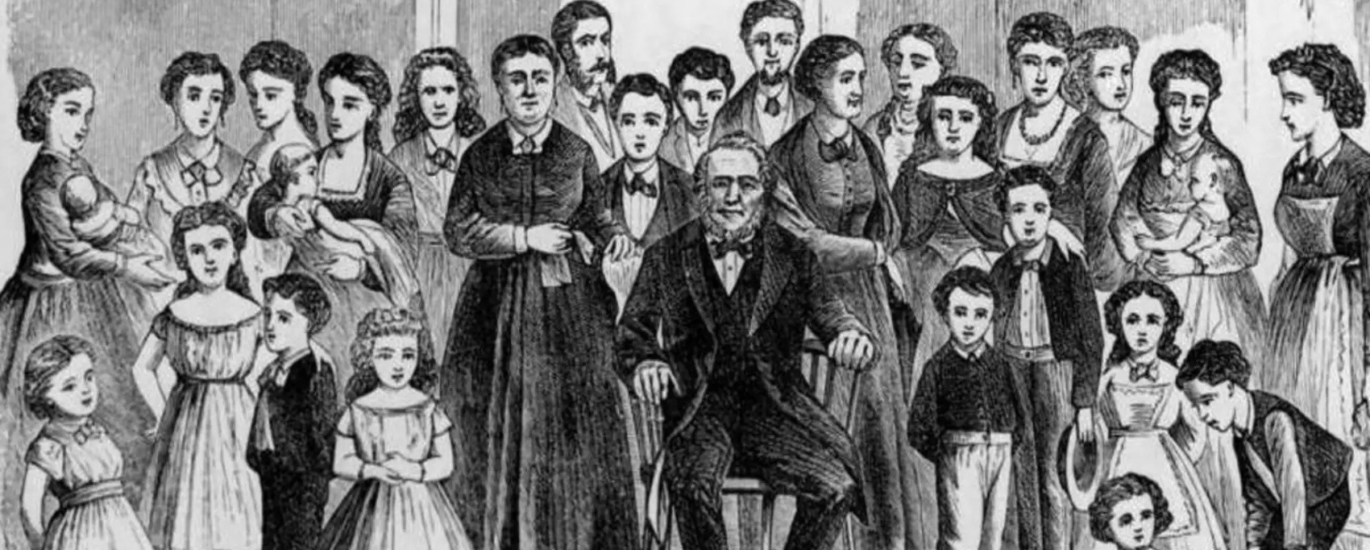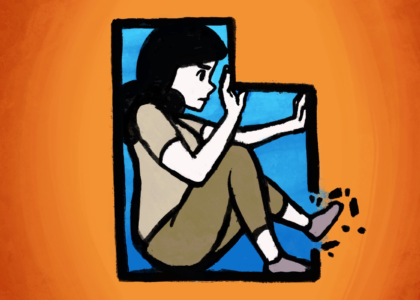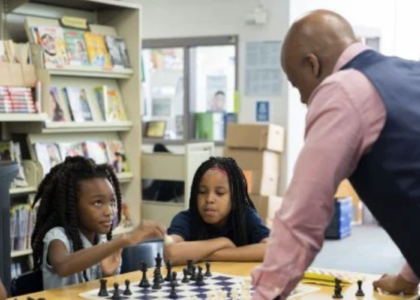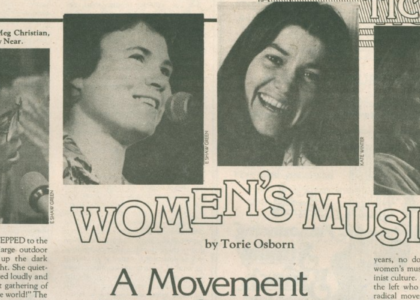“I didn’t think it was too much to ask that God and his church be better than everything else.”
This week Amy is joined by Shannon Johnson to help us zoom in even further to more fully unpack the practice of polygamous marriage in the LDS church and its impact on individual women. Not only do we learn some surprising and essential history, but Shannon trusts us with the story of her own journey coming-of-age within the church community and wrestling with polygamy on a personal level.
Our Guest
Shannon Johnson

Shannon Olena Hyatt Johnson (she/her) grew up mostly in Utah and went to BYU, where she met her husband, who was also an English major. She has taught conversational English in Japan and Cairo, and now works in admin at Stanford. She is currently writing a master’s thesis on race, polygamy, and the Mormon family. Shannon has three daughters and a non-binary child, ranging in age from 11 to 21. Shannon likes hiking, yoga, British tv, and trashy romance novels.
Recommended Reading & Listening
Year of Polygamy (podcast) ~ Lindsay Hansen Park
Sunstone Mormon History Podcast (podcast) ~ Lindsay Hansen Park and Bryan Buchanan
Pioneers (poem read by author) ~ Carol Lynn Pearson
Your Sister in the Gospel: The Life of Jane Manning James, a Nineteenth-Century Black Mormon (book) ~ Quincy D. Newell
Sally in Three Worlds: An Indian Captive in the House of Brigham Young (book, also Audible) ~ Virginia Kerns
More Wives than One (book) ~ Kathryn Danes
“Heathen in Our Fair Land: Anti-Polygamy and Protestant Women’s Missions to Utah, 1869–1910” (PhD Thesis) ~ Jana Riess
The Mormon Question: Polygamy and Constitutional Conflict in Nineteenth-Century America (book) ~ Sarah Barringer Gordon
“The family, morality and social science in Anglo-American cooperative thought, 1813-1890” (PhD Thesis) ~ Tara Westover (also, Educated)
The Legacy of Adam-God in the Mormon Theology of Heteropatriarchy (blog post) ~ The Grand Scoobah
Doing the Works of Abraham: Mormon Polygamy―Its Origin, Practice, and Demise (book) ~ B. Carmon Hardy
Religion of a Different Color: Race and the Mormon Struggle for Whiteness (book) ~ W. Paul Reeve
Race and the Making of the Mormon People (book) ~ Max Perry Mueller
When I was 13 years old, I read in one of Mormonism’s sacred texts that Joseph Smith was commanded to “Go therefore and do the works of Abraham.” The “works of Abraham” were described as the taking of plural wives, just as the biblical patriarch Abraham had taken Sarah’s handmaid, Hagar, to wife when his first wife Sarah was barren. At the time, I was happy, innocent, and a very young 13. My family were devout and loving. They accepted my early feminist inclinations and my ambitious educational aspirations. I read that night, in my cozy basement bedroom, about Emma Smith, Joseph’s first wife, who God threatened that she must “receive all those that have been given unto my Servant Joseph” otherwise, God warned: “if She will not abide this Commandment She Shall be destroyed.” I felt the most pervasive sense of wrongness.

The God of Doctrine and Covenants 132 bore no resemblance to the God I had been taught was a loving Heavenly Father, who knew me by name and who had a plan for my life and happiness. At church I was a leader in my female youth group. Each Sunday we stood to repeat the Young Women’s theme, which expressed our belief in God and our acknowledgment of his blessings to us and his expectations for us. When it was my turn to lead, I changed the first line from “I am a daughter of a Heavenly Father who loves me and I love him” to “I am a daughter of Heavenly Parents who love me, and I love them.” Each Sunday I felt a swelling of affection, security, and equal significance before God.
Joseph Smith began taking plural wives in the early 1830s, shortly after founding The Church of Jesus Christ of Latter-day Saints. He dictated a revelation on polygamy in July 1843. Doctrine and Covenants 132 refers to six Old Testament patriarchs: “Abraham, Isaac and Jacob” and “Moses, David and Solomon.” These patriarchs are held up as examples of the newly-restored practice of patriarchal or polygamous marriage. In Joseph’s lifetime, polygamy was a messy, furtive endeavor, marred by coercion, emotional and spiritual blackmail, deceit, “unauthorized” seductions, gossip, and accusatory affidavits.
There is evidence that Smith approached his first plural wife, Fanny Alger, through her male family members, though there were also rumors that he “loved” her. Smith’s pattern of grooming potential brides through their fathers and brothers or even through their husbands, can be interpreted in at least three different ways. First, Smith’s actions can be seen as simple obedience to God. Second, they can appear as a calculated move to build loyalty among his closest followers in the Church hierarchy – both by establishing an in-law relationship between the men and, by ensuring mutual culpability, especially in cases where Joseph offered to seal the woman’s male relatives to multiple wives of their own. Smith’s pattern of behavior can also be seen as part of his grand vision of uniting his own family with the families of his dearest friends and co-religionists, in an ever-expanding web of familial bonds that would eventually stretch back to Father Adam and forward till the Second Coming of Christ.
Joseph Smith pressured girls as young as 14, already-married women, and orphaned teenagers who were basically foster children in his household to marry him by promising both them and their families eternal salvation. He was also concerned with practicing polygamy the “right” way, for the purpose of establishing a grand patriarchal family. In both this life and the life to come, the main justification for practicing polygamy was reproduction. Just as Abraham had been promised an infinite righteous seed or posterity, so would Smith’s family expand forever with him at the head.
I didn’t know all of that when I was 13, though. When I asked my parents and leaders for help in making sense of the threatening God who required Emma Smith to share her husband with dozens of others or face destruction, I was also asking if I, too, would one day be required to share my husband with many wives. Polygamy, as practiced by the Mormons for about fifty years, was not the same as ethical, consensual polyamory. Instead, polygamy was a system in which first Joseph Smith, and then Brigham Young tightly controlled who could marry and who could divorce. Especially at the beginning, and again during the Mormon reformation of 1856 and 1857, men of high standing in the church were encouraged to take additional wives as a religious duty, and women were pressured into either accepting additional wives into their families, or into being the additional wives. Sometimes this was framed as being for the financial support of the widowed or orphaned, but it was usually taught as the ideal structure of marriage, the proper family formation in which to raise righteous children, and as a requirement for entering the highest degree of heaven, the Celestial Kingdom.
Joseph Smith pressured girls as young as 14, already-married women, and orphaned teenagers who were basically foster children in his household to marry him…
But polygamy was kind of a taboo topic at church. Instead of learning the history and theological underpinnings of the practice, I gathered pointed scraps of knowledge that wounded me again and again, even as I couldn’t stop hoarding them. I felt an instinctive revulsion at the idea that I would be forced, like Emma, to participate in something that felt wrong to me. I didn’t have the words to describe bodily autonomy or consent yet, but the ideas of selfhood and freedom were important to me.
When I was 14, I received my “Patriarchal Blessing” from a respected family friend, who was called to give teenagers personalized scripture to guide us in setting goals and to remind us of our place in God’s kingdom. The patriarch laid his hands on my head and double-checked my full name, “Shannon Olena Hyatt.” I told him my middle name came from my great-great grandmother Olena, who joined the church in Norway. My blessing contained promises about me marrying a man “mighty and strong” with whom I would raise children, if I was righteous and obedient in all things. Would all things include entering the patriarchal order or everlasting covenant of marriage? I had been taught, after all, to “liken the scriptures unto myself.”
When I likened Doctrine & Covenants 132 to myself, and read it in conjunction with my Patriarchal blessing, I felt horror and then shame at that horror, because I wanted to want to be obedient. How could God want something for me that I was sure was incompatible with my happiness? I was told that if and when I was asked to practice polygamy, it wouldn’t matter what I thought or felt about it now, because it wouldn’t be until I was in the Celestial Kingdom (aka after death). And at that point, my mind would be changed or God would help me understand, and it would feel okay, because God would soften my heart and fix how I thought and felt about polygamy. This was not comforting. Instead, I began to fear that, in addition to having to practice polygamy, there would occur a violation of my mind, in which I would no longer be me, even in my own head, because God would change my thoughts about something that I felt so strongly about, without my consent.
In high school I took AP American History and learned about Sally Hemings, her enslaver, Thomas Jefferson, and Martha Jefferson, Thomas’s first wife and Sally’s half-sister. I bristled when people called Sally Hemings Jefferson’s mistress. Though I was just starting to explore these concepts, I wondered about bodily autonomy and consent. Could an enslaved 16-year-old consent to a sexual relationship with the 46-year-old man who “owned” her and who would later be president of the United States? And then I thought about Mary, and Jesus, and Heavenly Father. Previous Mormon leaders have taught that Jesus was conceived “in the same way that your parents conceived you,” and that Mary was now a plural wife of Heavenly Father. I wondered if a young teenager two thousand years ago could give consent to, at worst, a sexual encounter with the omnipotent God of the Universe and at best (in more common Christian thought) an “overshadowing” by the Holy Spirit that resulted in 9 months of pregnancy and childbirth, and possible ostracism and punishment for perceived adultery?
At 20 I met my future husband Tom. My entire family immediately embraced him, noting that he was mighty and strong, and obviously a fulfillment of my patriarchal blessing. Four months after we met, we were set to be sealed, or married, in the Mormon temple, for “time and all eternity.” A week before our wedding, I started to worry about plural marriage. Would the covenants I was about to make in the temple include a promise to practice polygamy later on? Would I be committing myself in the most solemn and binding of ways to something I abhorred? Tom and I made an appointment with my stake president – an ecclesiastical leader similar to a Catholic bishop. He was also a renowned scripture and church history scholar. He wagged his finger in my face with exaggerated emphasis, reassuring me that the sealing ceremony only referred to husband and wife, with no mention of polygamy.
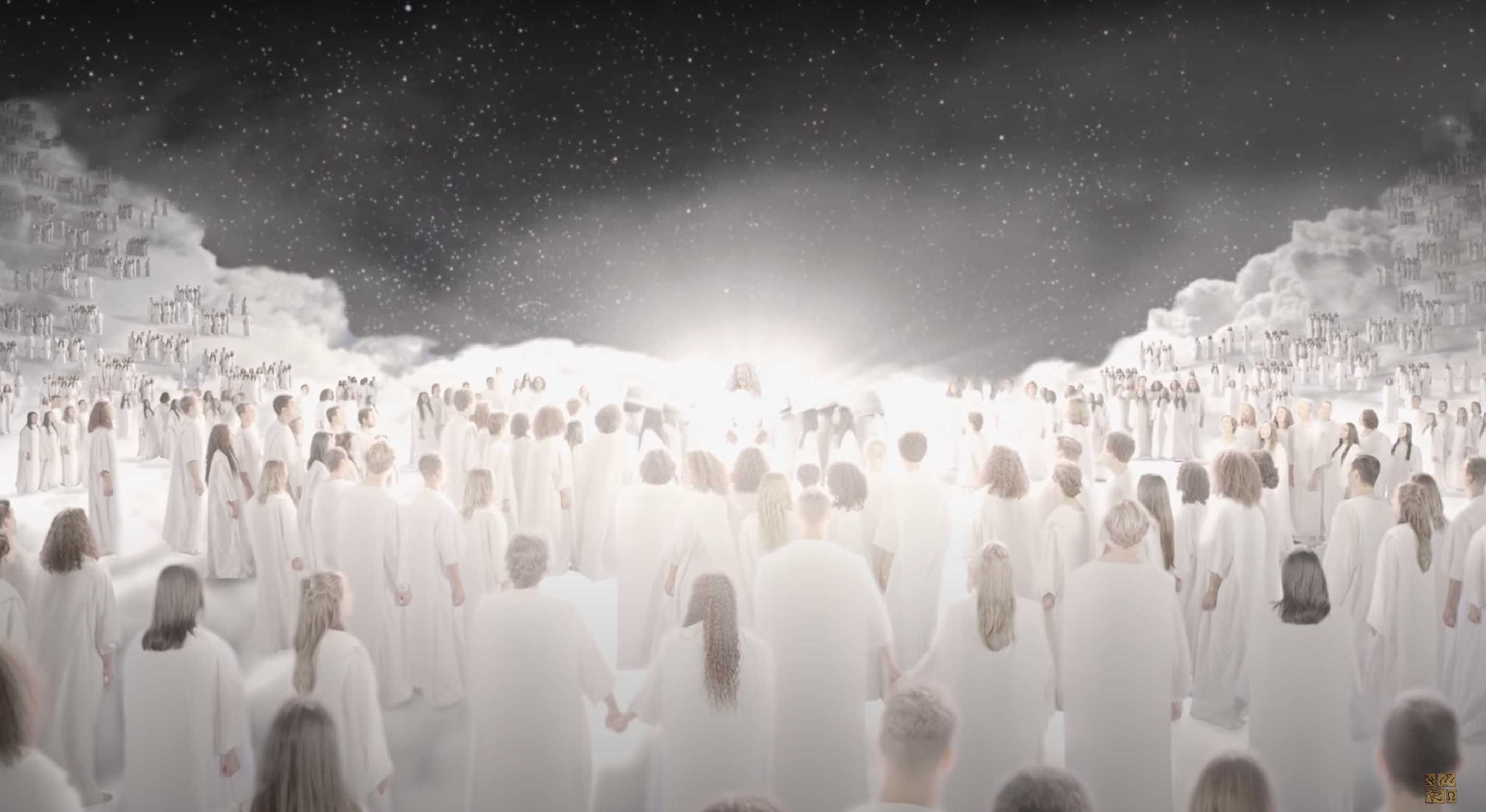
I began to fear that, in addition to having to practice polygamy, there would occur a violation of my mind, in which I would no longer be me, even in my own head, because God would change my thoughts about something that I felt so strongly about, without my consent.
I felt reassured in his authoritative presence, but the night before my wedding I started to worry again. I asked my dad to give me a father’s blessing, the last blessing I would ask for as his daughter, since after our wedding, my husband would take his place as the patriarchal leader of the new family we were forming. My dad laid his hands on my head and told me how much he and God loved me and that I was making the right choice in marrying Tom. I felt such peace and comfort. I sobbed through the entire ceremony the next day, but they were mostly happy, a little overwrought, tears.
Tom and I graduated from BYU together, taught English in Japan, and then moved to New York for Tom’s graduate school. I planned to apply the next year, but instead I followed the advice of my patriarchal blessing to not put off having kids. My first daughter was born in Manhattan, and then we were off to Cairo for two years. In Egypt I had a miscarriage and I asked Tom for a blessing. He laid his hands on my head and I felt comfort flow through me once again.
By the time I was 33 we had four daughters, and I started to worry about polygamy again. Tom’s patriarchal blessing said that he’d have daughters and sons. I started to joke that obviously I would soon be hit by a bus so Tom could remarry and his new wife could give him sons. As my own daughters got older and joined the same female youth group that I had enjoyed as a teenager, I felt more and more anger. Church became a near-constant source of pain as I tried to reconcile the joy I took in snuggling my babies with the frustrated certainty that I could no longer endure the strict gender roles and stark inequality in our doctrine and history.
At 35, Tom and I decided to leave the Mormon church. Sometimes it’s hard to remember how tumultuous that time was 8 years ago. I still believed in most of the church’s teachings, so I felt like I was breaking not only my parents’ and sibling’s hearts, but also breaking sacred covenants that were supposed to bind me for eternity to my family of origin and the family Tom and I were creating. But by that point I was so hurt and angry that I didn’t care. I still believed in God, I just hated everything about him. Joseph Smith reportedly said “I would rather go to hell with my friends than to heaven alone.” I decided I would rather go to hell with my self than to a Mormon heaven with the Mormon God..
And then I went back to school. Like Amy, I enrolled in a master’s program at Stanford to resituate myself in the world. As we studied the classics, mostly the foundations of western civilization, I realized how pervasive patriarchy is and how surprisingly well Mormonism fits within white supremacist narratives of Manifest Destiny, Western colonization, and American exceptionalism. When we read Milton’s Paradise Lost, I wrote an epic poem about Helen Mar Kimball, the 14-year-old that Joseph Smith manipulated into marriage. When we read Kierkegaard’s Fear and Trembling, I wrote about Joseph Smith’s Abrahamic trial of faith and how polygamy didn’t actually meet the requirements that Kierkegaard laid out. My dad asked me, “if sexism is everywhere, if the Constitution is sexist, if even the language we speak and think in is sexist, why are you so mad at the Mormon church for being sexist?” I didn’t think it was too much to ask that God and his church be better than everything else.
For my master’s thesis, I started researching the church’s history of racial restrictions, which denied Black members of the church the priesthood and temple ordinances that they would need to enter the Celestial Kingdom. And I discovered the most famous Black Mormon pioneer, Jane Manning James, who joined the church in the 1840s and worked as a domestic servant in the home of Joseph and Emma Smith a year before the prophet was killed. Jane later said that Emma had offered to adopt the twenty-something Jane as their own child. This was around the same time that Joseph wrote down the revelation on plural marriage that I read when I was 13.
Jane Elizabeth Manning was one of five young women living in the prophet’s home at the time. The other four, Maria and Sarah Lawrence and Emily and Eliza Partridge, told Jane that they were each plural wives of Joseph Smith. Jane was similar to the Partridge and Lawrence sisters in every respect except one: she was Black. In the next few years, Joseph Smith was martyred, and the Saints, including Jane Manning, migrated West. Jane married another Black Mormon, Isaac James, and their daughter was the first African-American child born in the Utah Territory.
Church became a near-constant source of pain as I tried to reconcile the joy I took in snuggling my babies with the frustrated certainty that I could no longer endure the strict gender roles and stark inequality in our doctrine and history.
Jane Manning James spent the rest of her life actively engaged in the church and in petitioning church presidents to receive the temple ordinances that Joseph had promised her. Finally, in 1894, Jane received a temple sealing, but it bore little resemblance to any ordinance before or since. Jane was “attached,” by proxy, “as a Servitor for eternity to the prophet Josep[h] Smith and in this capacity . . . connected with his family[, to] be obedient to him in all things in the Lord as a faithful Servitor.”
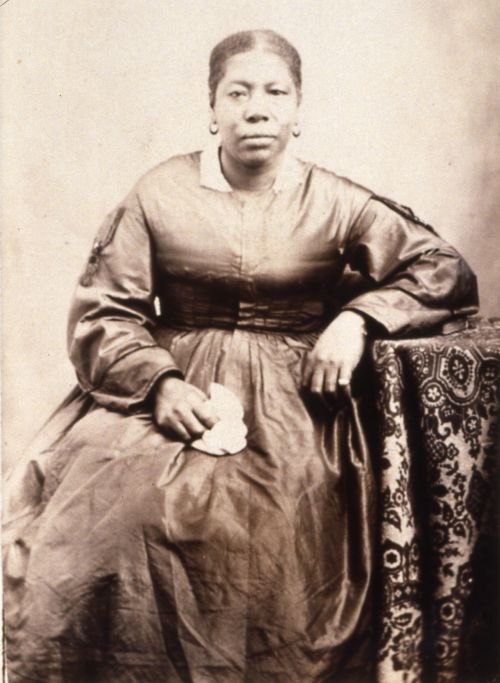
Jane spent the next 14 years until her death asking the church’s leaders to allow her the same temple ordinances that white Mormons took for granted. Joseph Smith’s teachings on polygamy, both in the revelation of 1843 and in private conversations with friends, reflected a belief in the possibility of eventual human perfection, and in the centrality of the family to human happiness both here on earth and in the eternities. His vision of human perfectibility, as found in the Book of Mormon, included white skin as a mark of God’s favor, and black or dark skin as a result of sin and as a warning against interracial marriage.
Joseph Smith, Brigham Young, and other Mormon prophets taught until recently that the Indigenous peoples of the United States were descendants of a remnant of the Twelve Tribes of Israel, and that their skin would literally become whiter when they embraced the gospel. William W. Phelps wrote to Brigham Young in 1861 about a revelation Joseph Smith had shared thirty years earlier. Phelps said that Joseph taught that the Indians, or Lamanites, as he called them, would become whiter as their women married Joseph and his associates and bore Mormon children. When Phelps later asked how Joseph and his friends would marry Indian women, seeing as they were all already married, Joseph said that they would take the women as plural wives, just as Abraham had taken Hagar.
In the context of heteropatriarchy and white supremacy, Mormon polygamy involved a high-ranking white man and his wives, most of whom would also be white and from a similar demographic, especially the first wife, but some of whom might be Indigenous or from a lower socioeconomic class. Such an interracial marriage did not operate in reverse – in other words, Indigenous men in Utah were not encouraged to take white women as wives, in fact this was rare among the Mormons, and it was not held up as an ideal or encouraged as a mechanism for absorbing a white woman into an Indigenous culture. Instead, it was intended that Indigenous women and their children would be incorporated into the Mormon faith and culture.
This version of polygamy, or polygyny, the marriage of one man and two or more women is called polycoity by some historians. It involves a primary wife of a higher caste and secondary wives of a lower caste. In the examples Joseph gave: Abraham, Jacob, Moses, Noah, and Solomon, the first wives of the biblical patriarchs were of high status, and often the same ethnic background or even close family group as the husband. Sarah was Abraham’s half-sister; Jacob’s first and second wives, the sisters Leah and Rachel, were his first cousins. Moses’ first wife Zipporah was the daughter of Jethro, a priest and prince of Midian. Solomon’s only named wife (out of 700), Naamah, was the daughter of the king of the Ammonites. By contrast, the secondary wives are of often a lower caste or marginalized race. Hagar, Abraham’s second wife was Sarah’s Egyptian slave or handmaid. Jacob’s secondary wives, Zilhah and Bilhah were Leah and Rachel’s handmaids, Moses’s second wife is described as being Cushite, or Ethiopian.
Defenders of plural marriage, including Brigham Young and Orson Pratt, taught that polygamy would produce healthier children than the sickly offspring of monogamous unions. Similar arguments were later made against interracial marriage, which was widely believed at the time to produce weaker children. Polygamy was a proto-eugenics project in which the most righteous religious leaders, who were all white at this point in Mormon history, would reproduce the most and influence the genetic pool with their stronger, healthier posterity. Mormon polygamy should be understood in the context of other nineteenth-century experiments in sexuality and family formation, including the Shakers and the Oneida Perfectionists, who were also interested in proto-eugenics and human perfectibility through the appropriate expression of sexuality.
We don’t know why Joseph didn’t ask Jane Manning James to be his wife, as he did the other young women living in his household. We do know that he was developing the sealing theology to include non-biological parent and child bonds as part of his project of sealing church members together into a grand “Mormon Chain of Belonging.” After the prophet’s death, Brigham Young used plural marriages, spiritual adoption sealings, and other temple rituals to help cement his claim to leadership of the church. Turning potential rivals into fathers-in-law, brothers-in-law, fellow adoptive parents, or adopted sons served to interconnect the church hierarchy into what Tara Westover calls a “supra-patriarchy” which stretches down to the present day.
Brigham Young later encouraged missionaries in Utah to take Indian women as plural wives. Some of them did, though not very many. On the other hand, Brigham warned that “If the white man who belongs to the chosen seed mixes his blood with the seed of Cain, the penalty, under the law of God, is death on the spot. This will always be so.” This variation on anti-Indigenous versus anti-Black racism isn’t terribly surprising in a United States that was founded on the principles of liberty for white landowners, massacres and forced removal for Indigenous peoples, and chattel slavery for Africans.
Polygamy was a proto-eugenics project in which the most righteous religious leaders, who were all white at this point in Mormon history, would reproduce the most and influence the genetic pool with their stronger, healthier posterity.
Most polygamist Mormons married wives of similar ethnic backgrounds, though secondary wives were often of lower socio-economic status, including recent immigrants from the UK and Scandinavia. America was scandalized in 1852 when the Mormons started publicizing and defending the practice of plural marriage. The Republican party platform of 1856 called slavery and polygamy the “twin relics of barbarism.” Polygamy was seen as one evidence of the power and immorality of the Mormon theocracy in the Utah Territory. After the Civil War, more legislative, judicial, and religious attention was focused on the Mormon’s continued defiance of the monogamous social norm. Congress passed anti-polygamy acts in the 1860s to 1880s, with increasing penalties for the church. The Supreme Court decided against the church in several polygamy cases from 1878-1890, and Protestant church congregations sent women on home missions to Utah.
The sheer magnitude of the United States’s animosity towards polygamy itself can be hard to comprehend, since it was happening so far away in the West, especially during the years of the Civil War. And after all, the Mormons’ defense of plural marriage had one good point – Male infidelity and the fathering of children outside the marital relationship were not uncommon in America. And a system in which men were required to support their dependents seems preferable to the system that led to a president of the United States fathering 6 children with his enslaved half-sister-in-law and never acknowledging them.
Polygamy posed several threats to the sensibilities and worldview of Protestant America. Sarah Barringer Gordon explains that legal theorists worried that polygamy would challenge the common law notion of coverture, since the legal fiction rested on the biblical ideal of husband and wife becoming one flesh, with the husband covering the wife and acting for her in the legal or public sphere. Multiplicity of wives threatened both this legal concept and the sentimental notion of romantic monogamy as the “biblical injunction for union in a kinder, gentler version of coverture.”.
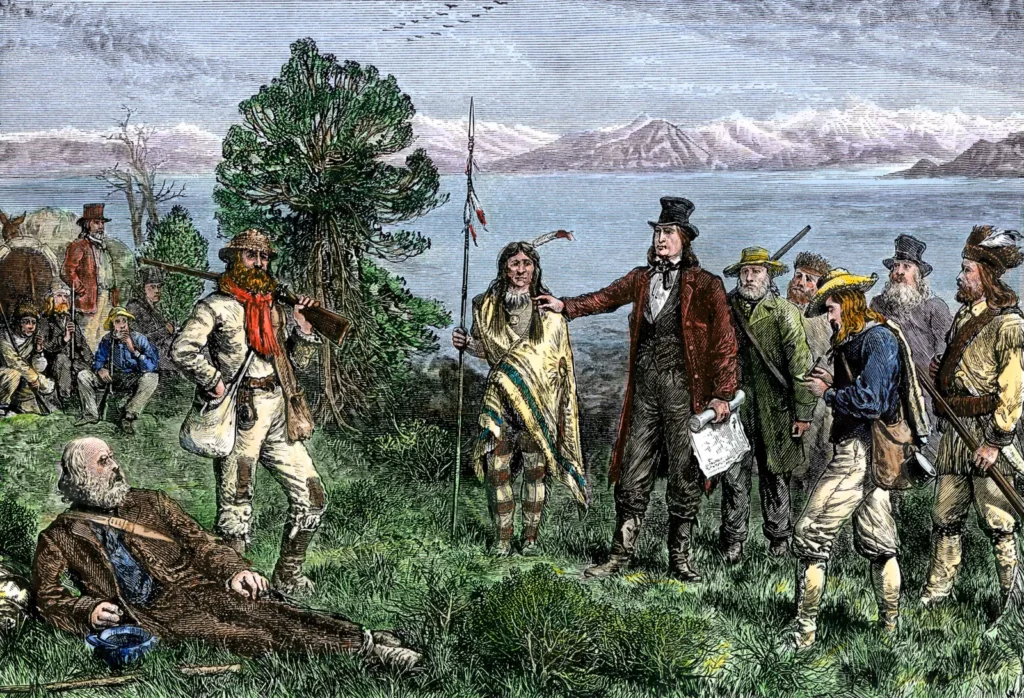
Protestant women missionaries had a more strictly-theological concern, as Jana Riess describes. Where the Protestant Reformation was seen as the beginning of female empowerment and progress (because now anyone could have a personal relationship with God and scripture, unmediated by the Catholic church or its all-male priesthood), Mormons were adding even more ordinances and even more intermediaries to those that the Reformation had dispensed with. Whereas Catholics and Protestants saw baptism as the fundamental saving ordinance, Mormonism added the requirement of celestial marriage for true exaltation or life with God and eternal progression. The Mormon church taught that a woman could not be exalted without marriage to a man who held the priesthood and who took her to the temple for a sealing ordinance, and that more glory was to be obtained through encouraging her husband to marry others and father as many children as possible. Mormon women did not appreciate the Protestant women’s efforts. Instead, they were seen as complicit in the undoing of hundreds of years of progress and in willingly submitting themselves to dominion in the form of patriarchal church leaders, as well as additional ritual requirements, unbearable marital arrangements, and patriarchal husbands whose absolute authority began on earth.
In 1902, Joseph F. Smith, nephew of Joseph Smith, and 6th president of the church, taught that: “The patriarchal order is of divine origin and will continue throughout time and eternity. ….In the home the presiding authority is always vested in the father, and in all home affairs and family matters there is no other authority paramount.… This patriarchal order has its divine spirit and purpose, and those who disregard it under one pretext or another are out of harmony with the spirit of God’s laws…. It is not merely a question of who is perhaps the best qualified. Neither is it wholly a question of who is living the most worthy life. It is a question largely of law and order, and its importance is seen often from the fact that the authority remains and is respected long after a man is really unworthy to exercise it.”
What the Protestant women didn’t anticipate was just how committed faithful Mormon women were to their principles, or how invested they were in relationships that they had sacrificed so much for – and the children they were responsible for. Mormons were defensive about their beliefs, traumatized from years of deprivation and hardship and persecution. The Mormon women who defended polygamy most vociferously in public were married to prominent Mormon leaders, privileged with resources and time enough to work for suffrage even as they protected their connections to powerful men and jealously guarded their access to the necessities of survival on the frontier. Many of them wrote privately of the hardships of plural marriage, encouraging each other to fix their affections on their children instead of relying on their husbands for emotional connection.
In leaving the church, I felt immense guilt for disappointing my parents, and for failing my ancestors, men and women who gave up everything they had to join the Mormons, who emigrated from England and Scotland and Norway. Some of them were polygamists, and remained faithful in incomprehensible circumstances. But a few did not. On my mom’s side, my great-great-great-great grandparents, Thomas Gammon and Elizabeth Day, joined the church in England and came to Utah in 1853. When Thomas was 36, he took a second wife. Sarah Ann Brown was also a convert from the UK, and she gave birth to a daughter three years later. Elizabeth’s granddaughter wrote: “This marriage did not set well with Grandma, so she told Grandpa he could have his choice but she would not live in polygamy. …Sarah Ann did not like polygamy either so she left Grandpa and went to Missouri, taking her little girl with her.”
On my dad’s side, my great-great-grandparents, Olene Marie Petersdatter Frisch and Andrew Sorenson joined the church in Norway, came to the U.S, and then emigrated to Utah by train in the 1870s. One of their sons worked in Brigham Young’s house. Another son, Oscar, was born in Utah. At some point, for some unrecorded reason, Olena and Andrew left the church and Utah, and settled in Wisconsin. They were so eager to forget their stay in Utah that Olena later recorded Oscar’s birthplace as “Western America,” and they never told their younger kids that they had been Mormon. One of their 11 children joined the church in Texas and later became my great-grandfather.
I don’t know why my parents named me for an apostate who probably left the church over polygamy. But I feel a connection to my ancestors, polygamous and not. I feel especially drawn to Olena, and Elizabeth, and even Sarah Ann, who I’m not actually related to. In fact, I’m almost grateful for polygamy now.
In the first installment of her amazing podcast, Year of Polygamy, Lindsay Hansen Park promised:
Although this information might be hard to take, remembering these women is important because they had a voice, an influence and a place in our Mormon history. Let’s honor them by remembering them and sharing the scraps of history we have to remember them by.
Clench your jaw, make sure you’re sitting down, read the following and we’ll get through this together. It will all be okay…
And she was right, eventually. I never practiced polygamy, but it took a lot from me. I lost my place in the spiritual home of my parents, grandparents, and my great-great-great-great grandparents. I lost my faith in an afterlife, my certainty that I would see my own children again after death, my identity as a unique and special child of God. Polygamy took away the trust I had in a God who was no respecter of persons, who loved his children, male and female, bound and free, Jew or Gentile, equally. It took away the promise I had built my life on, that if I sacrificed my own aspirations to stay home and raise righteous children, I would one day get to learn and do anything and everything as a priestess, queen, and co-creator with my husband.
But learning about the history of polygamy – how Joseph instituted it, how Brigham expanded it, how similar it was and is to other oppressive patriarchal systems around the world and throughout time – how some women suffered humiliations in a physical and emotional desert and some women defended it because they thought it was a test of their faith and humility – learning all of that set me free. Free to believe in a loving and egalitarian God or free to continue questioning, forever.
As Carol Lynn Pearson wrote in her poem, Pioneers,
“My people were Mormon pioneers. …
They stood in awe as truth / Flew by like a dove / And dropped a feather in the West. /
Where truth flies you follow / If you are a pioneer. /
I have searched the skies / And now and then / Another feather has fallen. /
I have packed the handcart again / Packed it with the precious things / And thrown away the rest. /
I will sing by the fires at night . . . Bring myself to morning prayer . . .
I face the plains / On a good day for walking. /
The sun rises / And the mist clears. /
I will be all right: / My people were Mormon Pioneers.”
Free to believe in a loving and egalitarian God
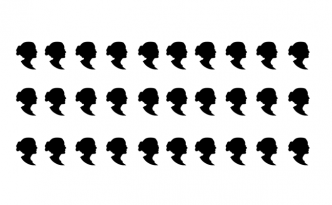
or free to continue questioning, forever.
Listen to the Episode
&
Share your Comments with us below!

